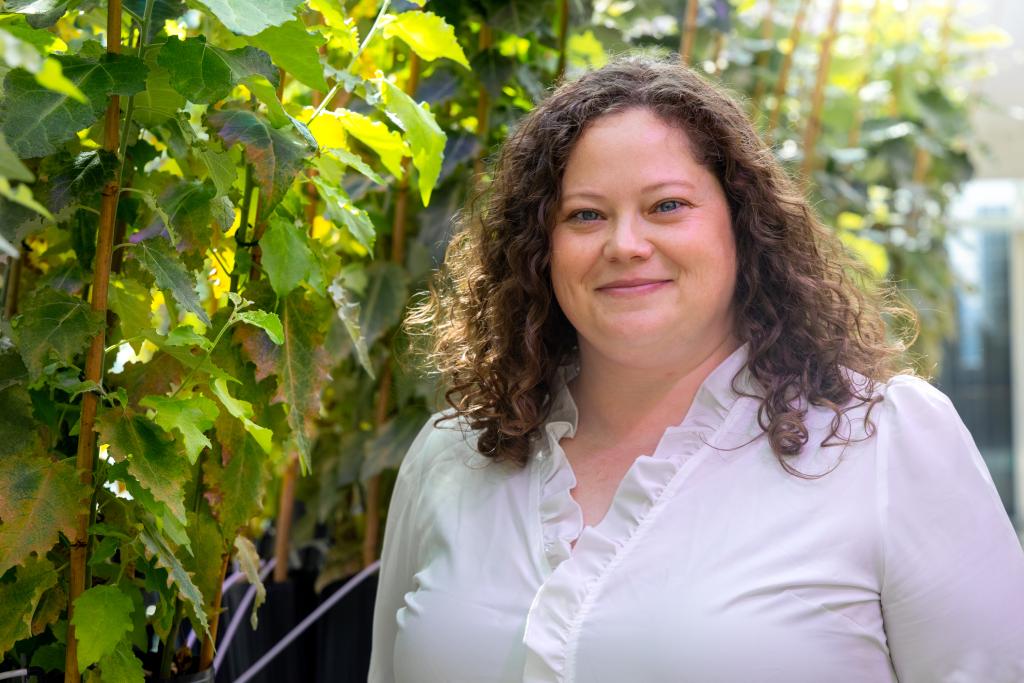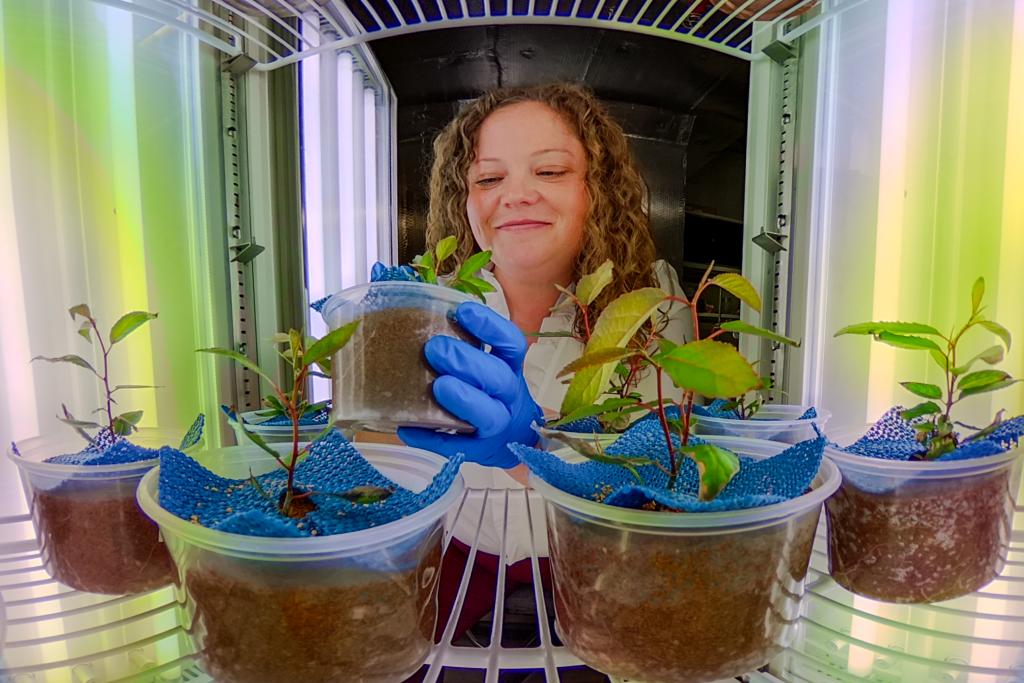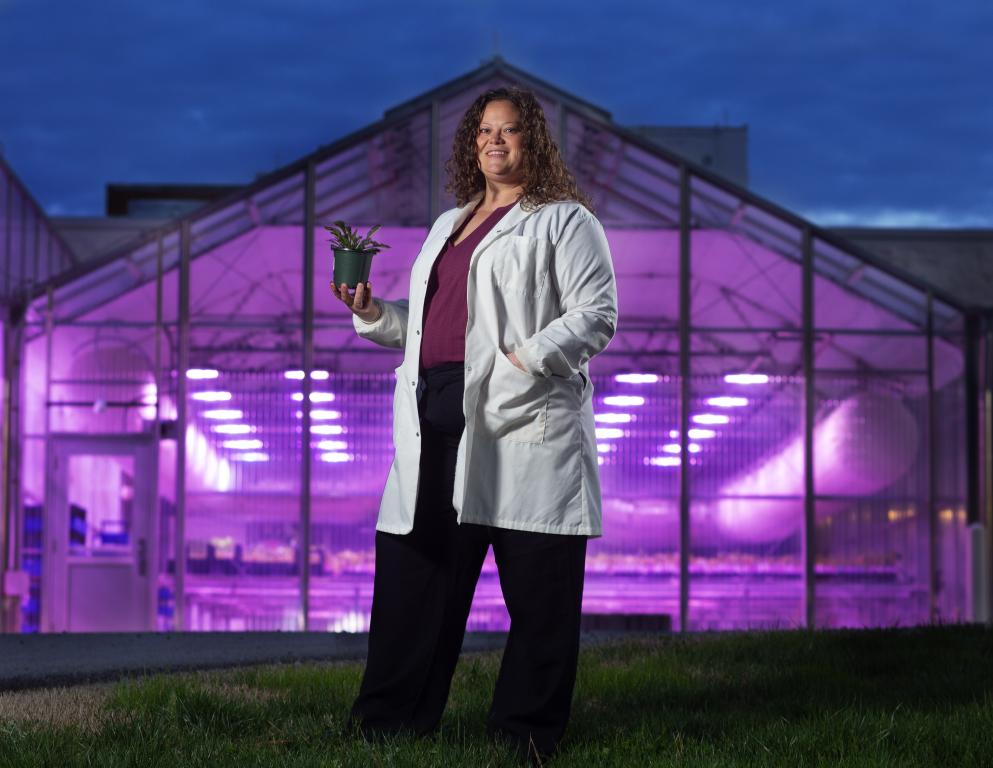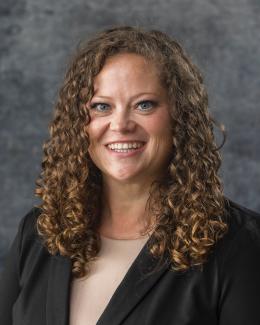
Alyssa Carrell, an ecologist with the Plant Systems Biology group at Oak Ridge National Laboratory, started her science career studying the tallest inhabitants in the forest, but today she is focused on some of its smallest — the microbial organisms that play an outsized role in plant health.
Just as the trillions of microbes found in the body play a crucial role in human health, the microbiome around plants influences the development and resilience of natural ecosystems by cycling nutrients, defending against disease and pests and boosting growth. A single gram of soil can contain several billion bacteria. The plant-microbe partnership underpins the success of plants grown for food, as feedstocks for bioenergy and as natural carbon storage.
In Carrell’s first project as a postdoctoral researcher at ORNL in 2015, she studied the development of a moss species, Sphagnum, that creates the wet, acidic peatland environment storing a full third of the world’s soil carbon.
“I had never thought of moss as an interesting species,” Carrell said. In her doctoral work, for instance, she had focused on large plants, specifically high-elevation pine trees.
“When you first hear about moss, it doesn’t seem that glamorous,” Carrell said. “It’s a tiny plant; it doesn’t have roots. But most people, myself included, soon become captivated by it. Sphagnum has an amazing ability to capture carbon and hold it in an ecosystem. It flourishes in some of the harshest environments on Earth. It’s also an ancient plant, and what you discover about its relationships with microbes can translate into other plant species, and then we can enhance those beneficial interactions across multiple systems.”

The moss is under threat today from a warming climate. ORNL scientists have proven that elevated temperatures can result in carbon loss from peatlands, including the release of heat-trapping greenhouse gases. Carrell and her colleagues are rapidly working out the genetic links to certain traits in Sphagnum that can increase its resilience to heat and other stressors. They have teased apart how microbial communities are affected by peatland warming and discovered sex differences in mosses that appear to influence the carbon storage process.
“We’re working to disentangle some of the interactions between plants and microbiomes so we can engineer the environment to enhance plant productivity, nutrient uptake and stress tolerance,” Carrell said. As an R&D staff member, Carrell works with colleagues in the Department of Energy’s Plant-Microbe Interfaces Science Focus Area and the Center for Bioenergy Innovation at ORNL to take what they’ve learned about a Sphagnum microbiome that is conditioned to a high-temperature environment and translate it into improved traits in other plants such as poplar, a key tree of interest as a bioenergy feedstock.
Natural curiosity and early science engagement
Carrell felt pretty far removed from science growing up in the sparsely populated town of Dorris in the high desert of northern California. “Lots of potatoes and cows,” she said. Her mother was single and raising three kids but took the time to encourage her children’s natural curiosity at every turn. “My mom is a geology nerd. She belongs to a rock club, and we’d go out hunting for geodes,” Carrell said. Any time the family traveled to a new city, they made sure to visit museums, including a whirlwind tour of every Smithsonian Institute museum during a road trip to Washington, D.C.
Carrell recalled impressionable experiences like creating a presentation on the migratory routes of the bald eagles that nested around her hometown and then visiting area schools to talk about it. She also participated in a third-grade project that involved documenting the development of fish eggs into juvenile rainbow trout and releasing them into a river as part of a watershed restoration project. “But it still didn’t feel like science or something that would translate into a career at the time. It was just fun and interesting,” she said.
As a freshman at the University of California, Merced, she intended to become a doctor. “At the time I thought that if you liked biology, medicine was your only option,” Carrell said. But she was soon introduced to the field of ecology, including internships with the U.S. Fish and Wildlife Service where she engaged in activities ranging from vegetation and bird surveys to the development of a water quality monitoring system for wetlands.
Carrell later entered the graduate studies program at UC Merced, intent on a master’s degree that could lead to a permanent position with the Fish and Wildlife agency. However, she was encouraged by her adviser to cast a wider net and pursue a doctorate. Carrell continued her studies and, as a doctoral student, joined a lab focused on microorganisms inhabiting plants, which led her to study the impact of microbes on high-elevation pine fields.
“Research is not like the classroom,” Carrell said. “Some people think of science as just memorization. But you use your knowledge to actively answer questions, to engage in problem-solving.” During this time, Carrell gained experimental skills in a wet lab while also working on scripting and coding. “I ended up with a diverse skillset, and that’s a good thing to have at a national lab where you need to pivot and move toward the next question rather than focus on one very specific niche topic.”

Limitless opportunities at the lab
It was through a connection her doctorate adviser made with ORNL scientist Dave Weston that Carrell was introduced to the national laboratory system. Weston invited Carrell to ORNL to discuss research opportunities and learn more about his focus on plant-microbe interactions. This was also Carrell’s introduction to Sphagnum. Weston was studying the moss as part of his DOE Early Career Research award, including field work at the ORNL-led Spruce and Peatland Responses Under Changing Environments ecosystem manipulation experiment.
“Dave was the first person to talk to me about Sphagnum. He even had a picture of the moss on his office wall. We tossed around science ideas, and he opened doors for me at ORNL. His mentorship has been significant to my success here,” Carrell said.
Carrell’s personal motivation with her research is to scale up what she’s discovering about the plant-microbe relationship to help mitigate climate change. “It is important to give natural ecosystems resilience to what we expect to see in the future, like increased rain and drought cycles. If you can harness the microbiome to help plants weather some of that, it’s central in terms of our bioenergy questions and also for environmental health and ultimately the economy.”
Carrell values the diverse research opportunities available at the lab. “You’re always growing at ORNL and there’s always someone here who can you help you on your path. It’s almost limitless,” Carrell said.
She encourages young people interested in science to participate in internships and research experiences. “Exposure to science really helps you choose your path, and you make connections who can guide you along the way,” Carrell said. “This is especially true if you feel like an outsider at times, as I have. I didn’t have anyone in my family or close network who was a scientist, so identifying the people who can help you navigate the system is important. Find voices that can help elevate you, even when you can’t always be at the table or you don’t know to be at the table. It’s impossible to do it all on your own.”
UT-Battelle manages ORNL for the Department of Energy’s Office of Science, the single largest supporter of basic research in the physical sciences in the United States. The Office of Science is working to address some of the most pressing challenges of our time. For more information, please visit energy.gov/science. — Stephanie Seay


